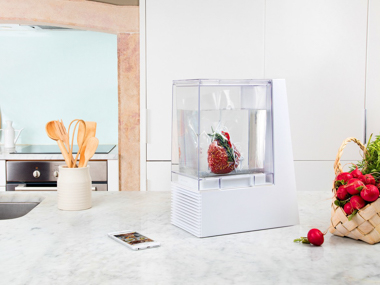Like To Party In The Danger Zone? Make Dinner In The Mellow
Wired—January 4, 2018

About two months ago, on a solo afternoon where I didn’t feel like being alone, I lured my buddy Ted over for dinner with some lovely, high-end pork chops. Ted loves a good meal and is Homer Simpson-esqe in his appreciation of well-prepared meat.
I was testing a new $399 sous vide machine called the Mellow, a sort of space-age aquarium with sharp lines, app control, and the ability to both keep food cold then cook it, all in the same tub of water—a modern spin on the set-it-and-forget-it slow cooker. I dropped the bagged chops in the water bath in the afternoon, and the Mellow cooled them until it was time for the cooking to begin two hours later. At that point, it heated the sous vide bath and had them ready for a quick sear right at dinner time. Ted didn’t disappoint either, tearing into the perfect medium-rare chops with zeal.
Among the “busy people” throughlines of Mellow’s homepage video, one of the stories shows a dad hopeless enough to be feeding his grade-schooler some sort of microwave meal, selling it with that “lips-kissing-fingertips” gesture, before graduating to a Mellow-made dinner for the smiling tyke.
The pork chops were my second success of the day. At lunchtime, I had used the Mellow with equally stellar results, making some cod that I cooked in the bag with a white miso marinade. Served with some rocket and a smashed roast potato, it was a luxurious lunch.
Following those meals, I looked back at the time-temperature chart that the Mellow’s app creates and saves for each meal, and was surprised how gradually the temperature dropped in the cooling stage. The cod was only in the water for 41 minutes before it started heating up, but the chops were in there much longer. Though the charts for each had low resolution, the machine seemed surprisingly confident lounging around in what the USDA calls the “danger zone”—the temperatures between 40 and 140 degrees Fahrenheit where the warmth encourages bacterial growth in foods like fish, meat, and poultry.
Anybody who’s ever earned a food-handler’s permit is familiar with the danger zone. The idea is to keep food out of the zone, but if you do need to pass through it, do it quickly, keeping harmful bacteria and the toxins some of them produce at bay. To keep it simple, the USDA advises home cooks to never leave food out of refrigeration for more than two hours.
There’s plenty of reason for caution; bacteria like Salmonella, E. coli, Campylobacter, Bacillus cereus, and Clostridium botulinum love to party in the danger zone.
Learn how the party in the danger zone went. Read the full story here in WIRED.